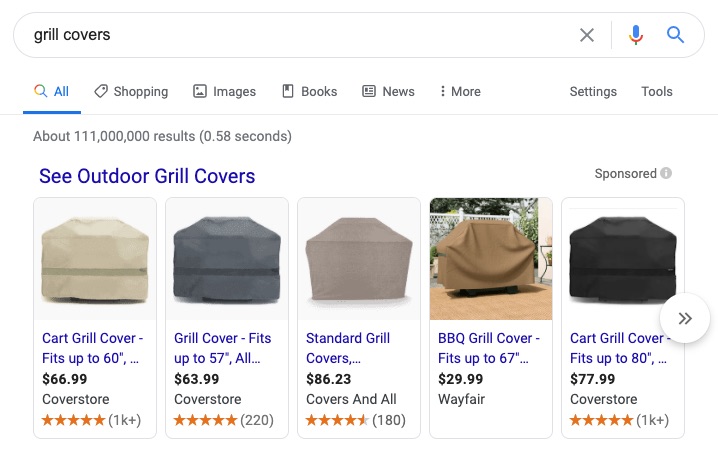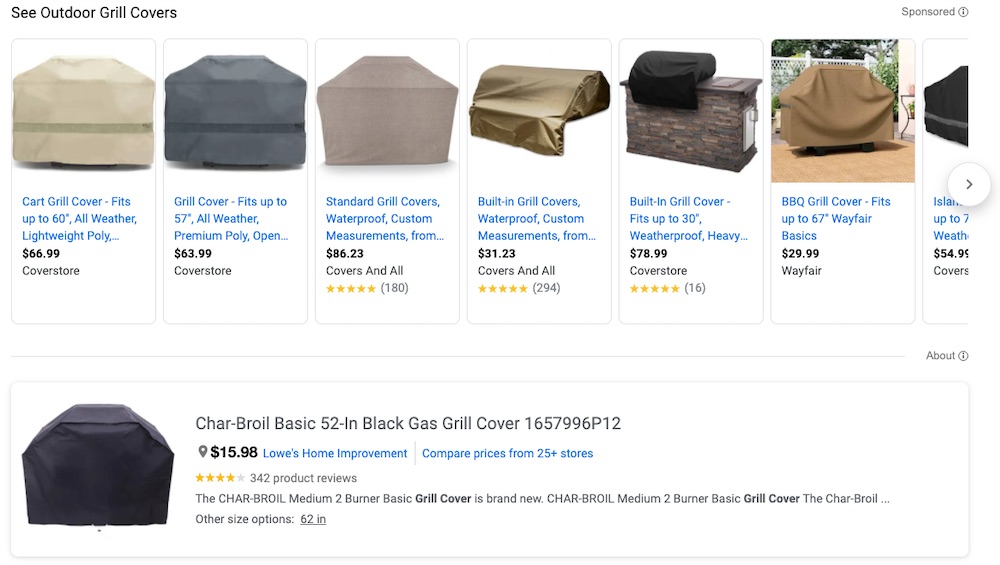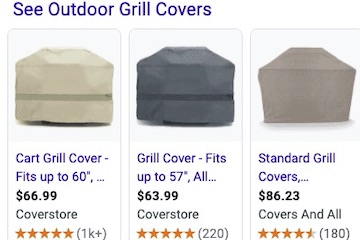In a surprise, Google announced on April 21 that a portion of listings on the Google Shopping tab would be free. Google had required sellers to create a Merchant Center account and run Shopping Ads through Google Ads. Henceforth, sellers with Shopping listings will still need a Merchant Center account but not Google Ads.
The notion of free Shopping listings may sound familiar. Google’s initial foray into comparison shopping, called Froogle, occurred in 2002. In 2007, Google renamed it to Product Search. Listings were free on Froogle and Product Search, although merchants could also run ads. Then, in 2012 it renamed again, to Google Shopping, and began charging for all listings.
What Is Changing?
Paid Shopping listings will still only appear on the main Google search page, as shown in the screenshot below for “grill covers:

Paid Shopping listings will now show on the main Google search.
The change comes when you click the “Shopping” tab. The page now contains a mix of paid (“Sponsored”) and free results.

The Shopping” tab now contains a mix of paid (“Sponsored”) and free results.
If you already run Shopping Ads, you will show free listings on the Google Shopping tab if, in Merchant Center, you opted into “Surfaces across Google. To confirm, go to the “Tools” section and then click “Surfaces across Google.” Assuming you have opted into the feature, you will see this screen:

To view the results from “Surfaces across Google,” go to Performance > Dashboard in the left navigation. Google shows a graph of unpaid (free) clicks, which commenced for many of my clients shortly after the April 21 announcement.
Google’s Rationale
The stated theme in Google’s announcement is to help merchants during the coronavirus pandemic. The press release stated, “With physical stores shuttered, digital commerce has become a lifeline for retailers. … In light of these challenges, we’re advancing our plans to make it free for merchants to sell on Google.”
However, as a longtime Google Ads consultant, I believe the rationale of free listings goes beyond the immediate crisis. Kirk Williams of ZATO, a pay-per-click marketing firm, breaks down the benefits for Google, which include (i) competing with Amazon and (ii) enticing merchants to participate in Shopping.
According to various surveys, more U.S. shoppers start their product searches on Amazon than Google. Allowing merchants to list on Shopping for free will enable more businesses and products available for searchers, and thus combat Amazon’s lead.
Moreover, Google now has a free offering where Amazon does not. Merchants can create free stores on Amazon, but Amazon takes a cut of each sale. The only requirement of merchants on Google is the creation of the product feed.
And enticing merchants to participate in Shopping will likely generate advertising revenue. That’s the second benefit.
Drop the Ads?
Should you alter your Google Ads Shopping strategy? No.
The just-announced free listings will show only on the Shopping tab. The main search results page (the “All” tab) is unchanged. Google doesn’t segregate click and impression data for the main search and the Shopping tab. Likely most traffic comes from the main search, not the Shopping tab. Additionally, when consumers go to the Shopping tab, the paid listings will still show above the organic results.
To be sure, the free listings will generate traffic. But the Shopping ads will dominate. Thus advertisers should continue to create segmented Shopping campaigns that break out priority and budget by product. The importance of an optimized product feed will continue. An additional benefit is that paid and organic listings on the Shopping tab can now show concurrently.
In short, if you’re running Google Shopping Ads, don’t change.







